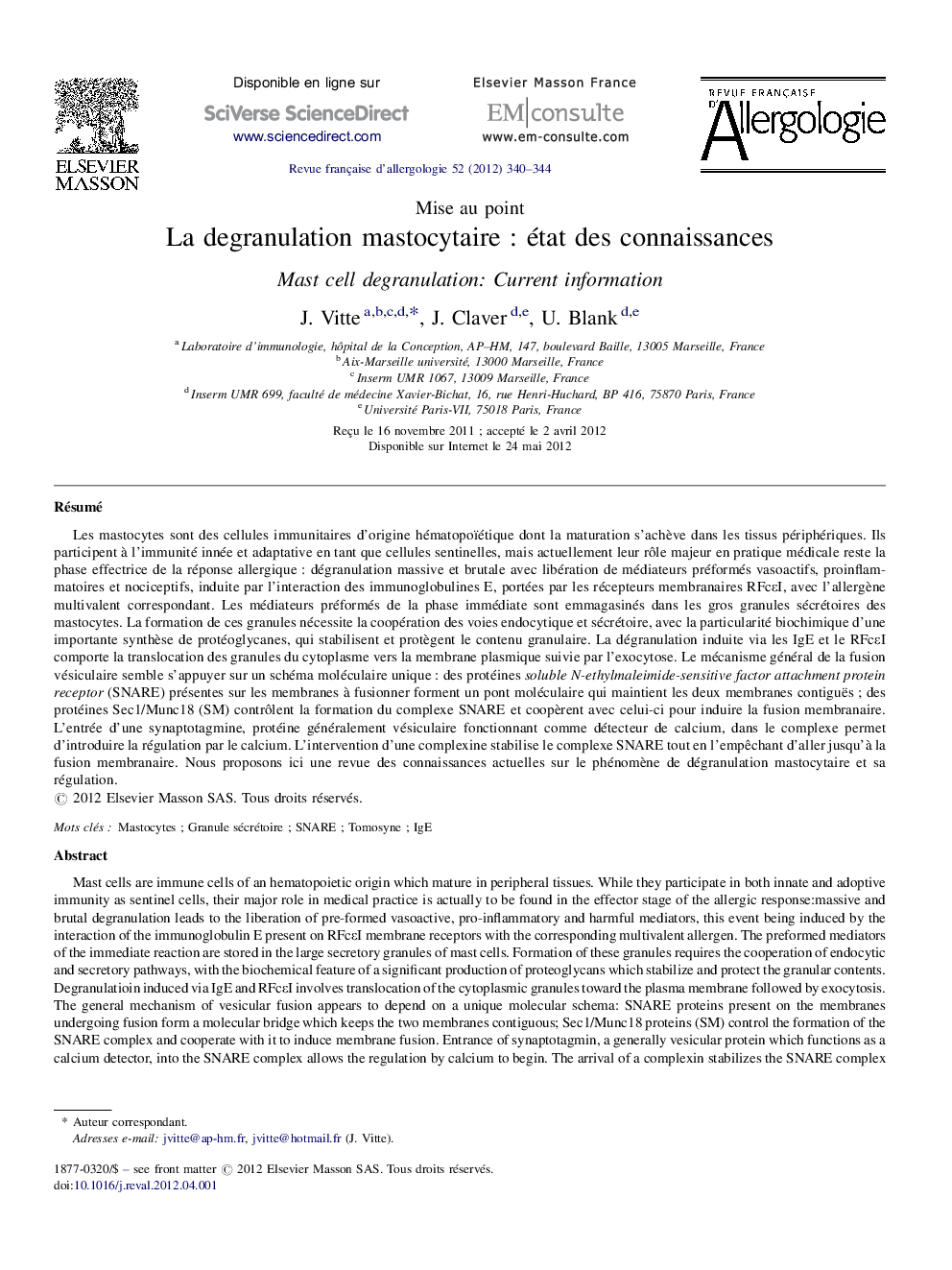| کد مقاله | کد نشریه | سال انتشار | مقاله انگلیسی | نسخه تمام متن |
|---|---|---|---|---|
| 3386189 | 1220640 | 2012 | 5 صفحه PDF | دانلود رایگان |

RésuméLes mastocytes sont des cellules immunitaires d’origine hématopoïétique dont la maturation s’achève dans les tissus périphériques. Ils participent à l’immunité innée et adaptative en tant que cellules sentinelles, mais actuellement leur rôle majeur en pratique médicale reste la phase effectrice de la réponse allergique : dégranulation massive et brutale avec libération de médiateurs préformés vasoactifs, proinflammatoires et nociceptifs, induite par l’interaction des immunoglobulines E, portées par les récepteurs membranaires RFcɛI, avec l’allergène multivalent correspondant. Les médiateurs préformés de la phase immédiate sont emmagasinés dans les gros granules sécrétoires des mastocytes. La formation de ces granules nécessite la coopération des voies endocytique et sécrétoire, avec la particularité biochimique d’une importante synthèse de protéoglycanes, qui stabilisent et protègent le contenu granulaire. La dégranulation induite via les IgE et le RFcɛI comporte la translocation des granules du cytoplasme vers la membrane plasmique suivie par l’exocytose. Le mécanisme général de la fusion vésiculaire semble s’appuyer sur un schéma moléculaire unique : des protéines soluble N-ethylmaleimide-sensitive factor attachment protein receptor (SNARE) présentes sur les membranes à fusionner forment un pont moléculaire qui maintient les deux membranes contiguës ; des protéines Sec1/Munc18 (SM) contrôlent la formation du complexe SNARE et coopèrent avec celui-ci pour induire la fusion membranaire. L’entrée d’une synaptotagmine, protéine généralement vésiculaire fonctionnant comme détecteur de calcium, dans le complexe permet d’introduire la régulation par le calcium. L’intervention d’une complexine stabilise le complexe SNARE tout en l’empêchant d’aller jusqu’à la fusion membranaire. Nous proposons ici une revue des connaissances actuelles sur le phénomène de dégranulation mastocytaire et sa régulation.
Mast cells are immune cells of an hematopoietic origin which mature in peripheral tissues. While they participate in both innate and adoptive immunity as sentinel cells, their major role in medical practice is actually to be found in the effector stage of the allergic response:massive and brutal degranulation leads to the liberation of pre-formed vasoactive, pro-inflammatory and harmful mediators, this event being induced by the interaction of the immunoglobulin E present on RFcɛI membrane receptors with the corresponding multivalent allergen. The preformed mediators of the immediate reaction are stored in the large secretory granules of mast cells. Formation of these granules requires the cooperation of endocytic and secretory pathways, with the biochemical feature of a significant production of proteoglycans which stabilize and protect the granular contents. Degranulatioin induced via IgE and RFcɛI involves translocation of the cytoplasmic granules toward the plasma membrane followed by exocytosis. The general mechanism of vesicular fusion appears to depend on a unique molecular schema: SNARE proteins present on the membranes undergoing fusion form a molecular bridge which keeps the two membranes contiguous; Sec1/Munc18 proteins (SM) control the formation of the SNARE complex and cooperate with it to induce membrane fusion. Entrance of synaptotagmin, a generally vesicular protein which functions as a calcium detector, into the SNARE complex allows the regulation by calcium to begin. The arrival of a complexin stabilizes the SNARE complex while at the same time preventing it from going on to membrane fusion. Here we propose to review current information concerning the mast cell degranulation phenomenon and its regulation.
Journal: Revue Française d'Allergologie - Volume 52, Issue 4, June 2012, Pages 340–344